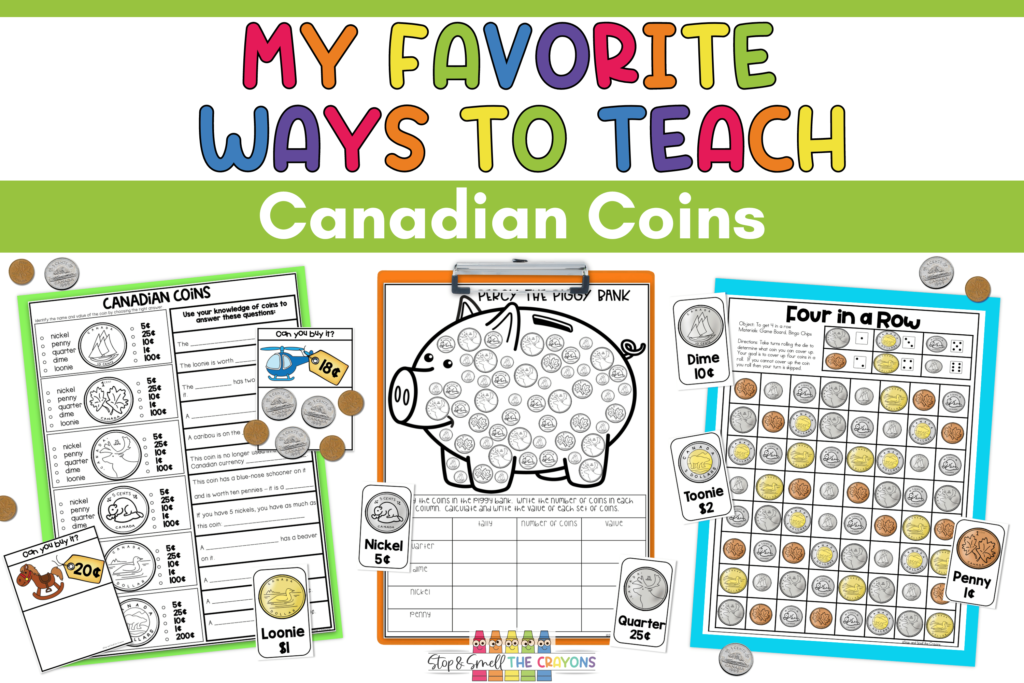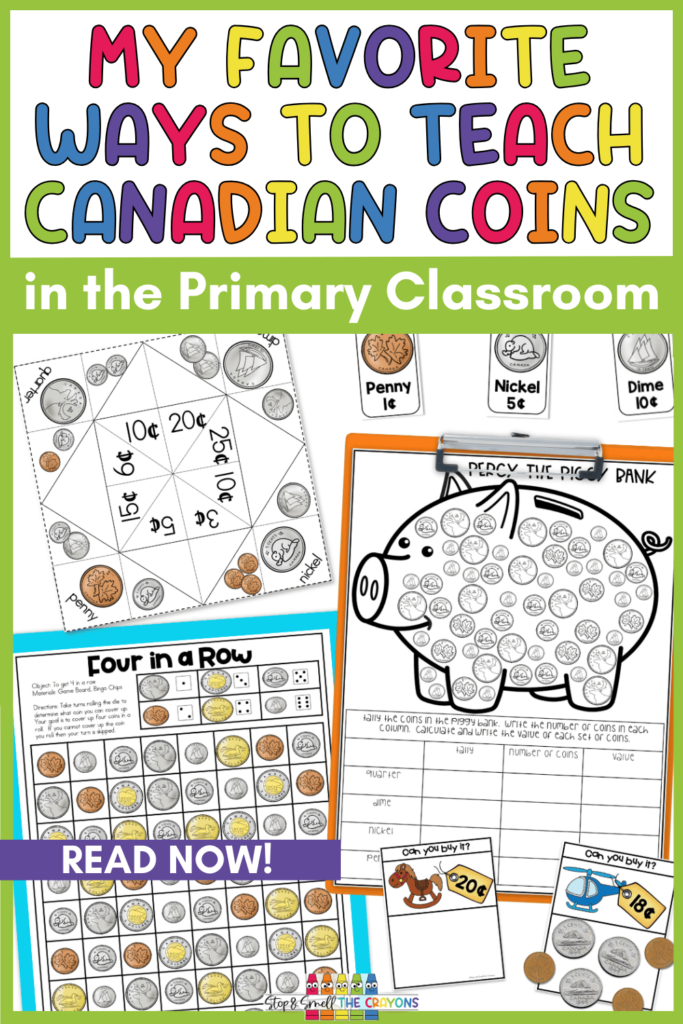Isn’t it amazing how using actual coins has become almost like a lost art, like reading an analog clock? When I think about my own spending habits, I realize I’m swiping my card way more often than I’m pulling out paper money or coins. Each year, when it’s time to teach my students about the value of Canadian coins, I see them struggle to wrap their heads around it. That’s why I’m excited to share some of my favorite go-to activities for teaching Canadian coins that make the learning process both fun and effective!

Why Do I Need to Spend Time Teaching Canadian Coins to My Students?
Even though we’re living in a world that’s all about tapping cards and making digital payments, understanding the value of Canadian coins is still a crucial life skill. It’s not just about recognizing the coins. It’s also about building a strong foundation in financial literacy. When my students learn about Canadian coins, they’re also learning essential math skills like counting, adding, and making change.

Beyond that, teaching Canadian coins helps our students develop problem-solving skills. They learn to think critically about how much things cost and how to use their money wisely. Plus, there are still plenty of situations where cash is used. They could want to buy something from a vending machine, save up change for a treat, or even participate in school fundraisers. Having a solid grasp of Canadian coins prepares them for these real-world experiences.
Let’s be honest. There’s something so satisfying about physically handling money and connecting it to real-world scenarios. Whether it’s through interactive activities or hands-on practice, teaching Canadian coins is about giving my students the confidence to handle money in their everyday lives. So, while it might seem old-fashioned, I believe that teaching Canadian coins is still incredibly valuable for my students’ overall learning experience!
Tips for Teaching Canadian Coins
I want to share my favorite tips for teaching Canadian coins. These activities have made a difference in my classroom. They help reach different learners to understand these coins better!
I start by making sure my students can identify each coin. We look at the size, shape, and the images on the coins. I love using real coins whenever possible because there’s something about that tactile experience that helps the information stick. If real coins aren’t available, plastic ones work. I throw in some fun games for students to help with motivation and engagement.

Then, I make sure to make it relatable. I’ve found that students learn best when connecting their learning to their everyday lives. So, I create scenarios where they might use coins. I might describe scenarios where they buy snacks or save up for a toy. Sometimes, I even set up a mini-store in the classroom where they must “pay” for items with Canadian coins. These activities make learning fun and give my students practical experience.
Another tip is to incorporate Canadian coins into morning meeting or math lessons wherever possible. Try to include them in counting exercises, making change, or word problems. Weaving coins into our daily math makes it less of a standalone topic and more of an integrated part of learning. I’ve seen my students’ confidence grow as they start to feel more comfortable using coins in different contexts.
I encourage patience. There will be moments where you might feel stuck because it’s just not clicking as you thought with some students. Some students may need more time to grasp the value of Canadian coins, and that’s okay! I like to celebrate the small victories. With a little persistence and creativity, teaching Canadian coins can be a fun and rewarding experience for you and your students.
Activities for Teaching Canadian Coins
Now that we’ve covered some helpful tips let me tell you about my Canadian Money bundle, which has made a huge difference in my classroom! This bundle is packed with four different resources that are designed to boost engagement and deepen our students’ understanding of Canadian coins. Whether you’re looking for hands-on activities, interactive games, or practice worksheets, this bundle has it all. I’ve found that these resources make learning about Canadian coins more fun and also help reinforce those essential skills we’ve talked about.
Canadian Coin Games
One of the things I love about my Canadian Money bundle is how it combines learning with hands-on fun. The games below are perfect examples! Let me walk you through a few of my favorites and how I use them in my classroom to teach Canadian coins.

Four in a Row
Four in a Row is a big hit with my students. It’s a simple group game where they roll a die to determine which coin they can cover on their game board. The goal is to cover four coins in a row. It’s great for reinforcing coin recognition and values in a way that feels more like play than work. I usually set this game up as a center activity, which never fails to engage my students.
Money Bingo
Money Bingo is another fun group game that I love using. The game includes a spinner to match the letters and coins. Students need to cover the right spots on their bingo cards. It’s fantastic for building quick recall of coin values. My kiddos get so excited when they’re close to getting bingo! This game is perfect for a whole-class activity or a smaller group, depending on how much time we have.
Piggy Bank Task Cards
Piggy Bank Task Cards are a great tool for differentiated learning. I use them to challenge my students at different levels. Each card has a piggy bank with a specific amount. My students have to match the coins to that amount. For my advanced students, I keep the extra challenge cards that allow for multiple correct answers. This makes them think a bit deeper about the different ways to make the same total. This is another center activity that I rotate through, and my students always enjoy the challenge.
Can You Buy It?

Can You Buy It? is a fantastic game where my students use plastic coins to “buy” items on cards. I love how this game combines both coin recognition and practical math skills. My students have to calculate the right amount of coins to match the price of the toys on the cards. This helps them understand the value of each coin. As a bonus challenge, I sometimes use blank cards to create new prices to push my students to adapt their calculations. It’s always fun to see them so focused on figuring out if they can afford their “purchases.”
These are just a few examples of the games in the bundle! There are several more included, but what I really appreciate about these games is how they allow students to practice and reinforce their learning in a variety of ways. Whether it’s through hands-on activities or problem-solving tasks, these games have become essential tools in my teaching toolbox for helping my students master Canadian coins.
Canadian Money Worksheets
Another fantastic resource in my Canadian Money bundle is the Canadian Money worksheets. These worksheets are a wonderful way to reinforce coin recognition, counting skills, and problem-solving with Canadian coins. I use these worksheets in a variety of ways. They work well for independent practice, homework, or even as assessments to check our students’ understanding.

One of my favorite worksheets is the Counting Coins activity. This worksheet helps my students practice counting by 1s, 5s, 10s, and 25s, depending on the coin. It’s a great way to build fluency with adding coin values. I love how it gets my students thinking strategically about which coins to count first. I often use this worksheet as a warm-up activity to get my students in the right mindset for our money lessons.
Another go-to worksheet is the Make the Change activity. Here, my students have to figure out how to make specific amounts using different combinations of coins. It’s perfect for challenging them to think critically and explore multiple solutions to a problem. I’ve found that this worksheet really helps solidify their understanding of how coins can be traded or combined to make different amounts.
For a bit of fun, the What’s Your Pig Worth? game-like worksheet is a big hit in my classroom. Students roll a die and move around the board. As they go, they cross off piggy banks with specific amounts. The goal is to get three amounts in a row. It’s a playful way to practice counting and recognizing coin values, and my students always get a kick out of it.
Coin Labels for Canadian Coins and US Coins

The next resource in my Canadian Money bundle is all about Coin Labels. Each label clearly shows the name and value of the coin, from the toonie down to the penny. These visuals are perfect for helping our students get familiar with what each coin looks like and how much it’s worth. I love to use these labels in a variety of ways. Sometimes, I’ll have students match the labels to images of coins on a worksheet. I’ll use them as part of a classroom display to reinforce coin recognition daily.
What’s great about these labels is that they’re so versatile. I’ve even used them in interactive games where students have to match the labels to amounts of money or use them as flashcards for quick review sessions. When real coins aren’t available, these labels still give students that visual connection they need to grasp the concepts.
Canadian Coins Cootie Catcher

The last resource in my Canadian Money bundle is another fan favorite among my students, which is the Canadian Coins Cootie Catcher! Remember those classic paper fortune tellers we used to make as kids? Well, this is a playful twist on that idea, but with a focus on Canadian coins.
I love using this cootie catcher as a math center activity or even as a fun review game. It’s perfect for getting our students excited about learning and reinforcing their knowledge of Canadian coins in a way that feels like play. Each flap of the cootie catcher has questions about coin values. Our students have to answer correctly to unlock the next move. It’s a great way to mix up the usual routine and keep things interactive.
One of the things I appreciate most about this resource is how it encourages peer interaction. I have students work together, ask and answer questions, all while having a blast. It’s amazing how much learning can happen when our students are engaged and enjoying themselves. This cootie catcher is a prime example of that.
Additional Resources to Explore
Looking for more resources that engage students and make learning stick? Take some time to explore the resources listed below.
- Multiplication Activities Your Students Will Love
- How to Weave Spiral Review Into Your Class With Morning Work
Make Learning About Canadian Coins Memorable!
Making learning Canadian coins memorable is all about mixing fun, hands-on activities with practical, real-world connections. Whether it’s through engaging games, interactive worksheets, visual coin labels, or a playful cootie catcher, each of these resources in my bundle is designed to help your students understand Canadian coins while enjoying the process. I’ve seen firsthand how these activities can transform a challenging concept into something students look forward to. So, watch your students’ confidence with Canadian coins soar. Let’s make learning about money an experience they won’t forget!
Save for Later
Remember to save this post to your favorite math Pinterest board to use for planning out your Canadian coins activities!
